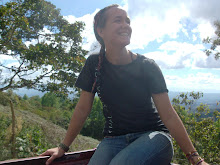Easter is not only an important week for the Church, it´s quite busy! I didn´t expect to be spending so much time at church, but was happy to be part of the Easter celebrations. Thursday night I went to mass where Father Craig washed the feet of several parishioners. Friday morning was Via Cruces, the re-enactment of the Passion. We processed through the town, following the youth of the parish who were dramatizing the Stations of the Cross. At each station there was an alfombra, an image made out of dyed sawdust. Each image was distinct and went with the station. They were also varying in size-one was big enough to cover the width of the front of the church!
On Friday I took part in two other processions through the streets. The first was led by a group of men carrying a glass casket decorated with flowers that held a statue of Jesus. We walked from the church to a cemetary, singing and praying along the way. The second procession was later Friday night, and traditionally only women were allowed to go. It´s meant to be a time to accompany Mary in her suffering, so we said the rosary and stopped at a few altars along the way. It was touching to see how many people were involved and willing to set up an altar in front of their home.
On Saturday night I went to the fire blessing, held a block down from our house. It started with a blessing of the Easter candle. After lighting the candle, we each lit our own individual candles and then processed through the streets to the church. When we arrived, the church was left in darkness, but lit up only by our individual candles. It was quite moving to see the symbolism, that each of us carries the light of Christ and in the end, people are what give life to the church. We listened to a few readings from the Old Testament while in the dark and then the lights went on, we sang, and listened to readings from the New Testament (at least I think that´s what was happening). It was a nice ceremony, and a beautiful way to welcome Easter day.
On Easter we went to mass in the morning, with the church decked out in green and white. When we went home, we did a treasure hunt! Tori had put clues throughout the house that led us to an Easter basket hid in the mango tree. She made us each a cross-shaped cookie accompanied by a mango bunny. (My favorite clue was: I´m a very expensive paperweight. It ended up being my crap computer. Haha) I was excited that we were able to have our own kind of Easter celebration, and one that reminded us of home. It was hard being away, but we were kindly invited to dinner at Father Craig´s with the Sisters. It certainly wasn´t the same as home (or Gram´s cooking), but was very nice to share the meal and holiday with such good company.
Overall, it was a lovely holiday. Towards the end of our break, I wasn´t sure how I felt about going back to school. It was nice to have time to ourselves and relax, and I was getting a bit spoiled. But over the weekend I saw a couple students and was filled with joy. I was so excited to see them both. It reassured me that I was ready to tackle another trimester with the students.
Every trimester we change classes, so after this review week and tests next week, we´ll be starting fresh. We won´t find out our exact assignments until tomorrow, but the main classes are English, Math, Psychology, and Economics. I´m looking forward to teaching something that I know well, instead of material that I have to learn first and then teach (like Spanish grammar or an analysis of a Honduran legend).
Hopefully I¨ll be able to post some pictures of the trip and of Semana Santa, but don´t hold your breath!
